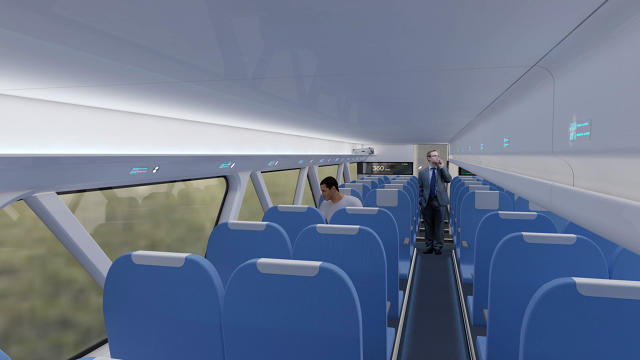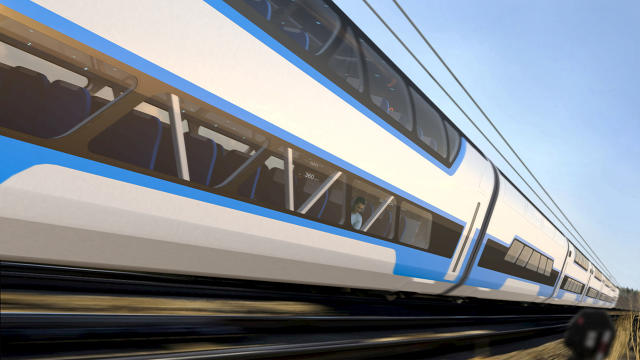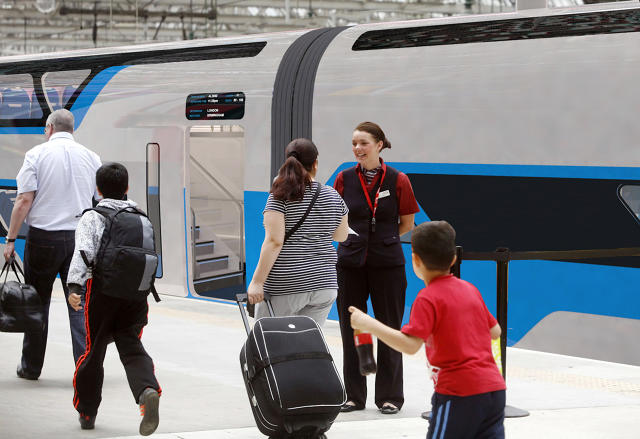It's well-documented that the United Kingdom's trains are overcrowded. Some regional lines are as much as 86% over capacity. Congestion plagues train systems all over the world from San Francisco to New York to Mumbai. The solution isn't as easy as putting more of the same trains into commission; it's about future-proofing the trains that come next.

Switzerland-based architect Andreas Vogler is working with Matteo Mazzero, Sebastian Wolf, and the German Aerospace Center on a concept for the U.K. called the Aeroliner3000. In the past, Vogler has worked on interiors for Asiana and Corsair airlines, concepts for space tourism, and a Mars rover. While transportation is an ongoing interest, the train represents a new category for him.
The Aeroliner3000 is one of three finalists in Tomorrow's Train Design Today, a competition hosted by the Royal Institute of British Architects (RIBA), the FutureRailway Team, and the Department for Transport (DfT). The aim is to find a way to reengineer passenger trains that can accommodate more capacity within the existing railway infrastructure of tracks, tunnels, and stations.
Their solution? Bring the train carriage closer to the track. That way you can create taller trains, which accommodate more passengers—think double-deckers—while still fitting through narrow tunnels and low bridges. Vogler and his team have completed a feasibility study and are working on a full-scale prototype, which will be exhibited in September 2016.
"It's changing some paradigms of a train," Vogler says of the Aeroliner3000. "It's more like a Learjet on rails." Below he walks us through the challenges and opportunities of designing a new train for the U.K.—and how these lessons could be applied to other transit systems around the world.
Co.Design: Where did and didn't you see opportunities for design to alleviate the problem of overcrowding?
Andreas Vogler: Britain has greatly invented the railways in the 19th century, but is also trapped in its historic infrastructure, which grew very fast by many private companies, who made the tunnels as small as possible to cut costs. It is the cost of liberal capitalism, that often a greater vision is missing. But that was 150 years ago.
However, British rail is a story of success with growing passenger numbers since the 1990s. British train operators so far have been catching this capacity growth with seat pitches reaching their ergonomic limits and by charging high prices during peak hours. However passenger numbers keep on growing, because the roads and the sky are full in Britain. It is a country on the move.

In continental Europe, double decker trains have helped. They increase a train's capacity by up to 50% without changing infrastructure. There, the loading gauge, historically, is large enough to allow that; in the U.K. it's not.
The very tight infrastructure in the U.K. is a major constraint to our design. Just four inches more in each direction would bring great benefits for the design. In the short term, the train we are designing could bring a relevant seating capacity increase without affecting the infrastructure at all. In the long term, we hope it starts a discussion on how the U.K. can create a rail infrastructure for the third millennium. The DLR has already developed some radical, but consequential, ideas in this direction.
What's unique about the challenges in the United Kingdom's railway system from other systems in Europe?
As mentioned above the British loading gauge is below four meters (about 13 feet) for a majority of the lines, where as the main lines of the continent are at around 4.5 meters (14.75 feet). Also the platform level in the U.K. is 915 mm (3 feet), whereas the European Union Technical Specifications for Interoperability (TSI) aim for 760 (2.5 feet) and 550 mm (1.8 feet), especially to accommodate double decker trains. This creates ergonomic challenges when increasing capacity. Also many rail stations are not really prepared for a capacity increase. You also need to think how to get people on and off a train. The train is a system, which you always need to considerate holistically.

How did you arrive at the "four Cs" of the design brief—capacity, low-carbon emissions through lightweight construction, customer comfort, and cost-sensitive innovation?
The four Cs have been adopted and aligned from central government policy and are common to most transport systems particularly aerospace and automotive. We have been expanding the diagram of the four Cs by additional orbits, which all interlock. If you make your coach lighter by clever engineering and you can fit more people you save energy and carbon emissions, but also costs while you increase capacity. Initial costs of the train maybe higher, but it starts saving as soon as it is running. The challenge is to increase passenger comfort, too, that's why we also have psychology in our diagram orbit. A lot of the misery of today's train travel—not only in the U.K.—is poor communication, poor psychology to make passengers happy, and poor passenger flow. We are working on a conceptual level on those fields as well. We should not forget the passenger is the most important element in the system.
Could your prototype for the U.K. could be applied elsewhere?
It could work in other places in the world there are low tunnels, for example in downtown Sydney. Also, we can think of double-decker underground trains in mega cities. A train with a lower profile also has a lower aerodynamic resistance, which saves energy and CO2 emissions.
Aging infrastructure is a challenge in cities and countries all around the world. Generally speaking, how can they start to think about future-proofing their railway systems?
The invention of the train was the entrance into mass transportation 200 years ago. It was the major means of travel for the rich and the poor before the invention of cars and airplanes. And astonishingly, today it's still one of the most competitive means of travel in terms of safety and pollution. Europe is developing high-speed networks, which starts to make many airline connections redundant.

There is still a lot of small-scale historic thinking in the train world. A larger vision of the style and grandeur train travel had in Victorian times is missing in the U.K. We need to work on that larger vision. Why should Google, Apple, and others build automatic cars which form little "trains" on the motorways, all with a lot of energy loss from individual engines running at 80 mph, when you could make them automatically drive on a car-carrying train stopping at major cities with a speed of 225 mph? Los Angeles to New York in your own electric car in 12 hours, while working, dining, and charging the batteries of you car.
Future trains could even have individually powered high-speed coaches, running independent and on demand, forming trains on the fly and decoupling at high speed to serve remote locations on demand. Trains could be the means of travel in the future, if the vision is right. The technology is already available in the present.